Amazing Malbec
POSTED ON 01/02/2010I am away in Italy for the tasting of the 2006 vintage of amarone (on which more soon), so meanwhile, instead of the usual weekly blog, here is my piece, Amazing Malbec, for Preferred Hotels Magazine, Vol V, Issue 2.
Take a popular French grape variety like Burgundy’s Chardonnay or the Cabernet Sauvignon of Bordeaux, transplant them in Australia say, and back they boomerang whence they came, New World clones often more generously flavoured and attractively priced than the original. Boiling it down to its essentials, that’s basically how the New World model has stormed the battlements of European consumer taste. I don’t use the word revolution lightly but the process has been revolutionary, creating not just satisfaction but an entire new breed of consumer. Where Burgundy or Bordeaux were often beyond our pocket and our ken, grape variety, New World style, has given us wine as a delicious drink to be enjoyed rather than dissected or used to browbeat others.
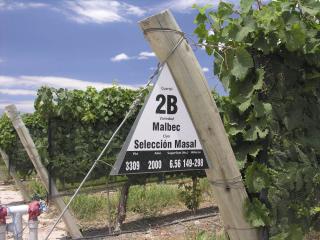 Malbec at Septima, Mendoza, Argentina
Malbec at Septima, Mendoza, Argentina
The French have watched these developments often with something of a jaundiced eye. Flattered on the one hand by imitation and proud that their grapes have been re-moulded in the image of Australia et al, they have watched as the rug of taste and price has been pulled from under them, having to resort to the desperate expedient of telling us that theirs is the one and only true terroir and will always be so. Even this is a moot point now that the New World is starting to produce high quality, complex wines which in many cases can give, and have given, Bordeaux and the classic regions of France a run for their euros.
There is one grape variety however in which the entire de haut en bas process has occurred in reverse and that’s the Malbec grape. Never considered one of the major varieties in its own country, or at least not since the devastation of the French vineyards by phylloxera in the 19th century, Malbec has been successfully transplanted in Argentina. In the high Andes on imperceptible inclines at 1000 metres and upwards, the climatic conditions have turned its wines, over decades, into the greatest examples of their kind in the world. Ironically, Cahors, the original epicentre of the Malbec grape in south-west France, has now seized the opportunity to hitch a ride on the coattails of Argentina and its producers are doing their damnedest to catch up.
 Cahorse, Cahorse, my kingdom for Cahorse
Cahorse, Cahorse, my kingdom for Cahorse
Yes, once upon a time in the south-west, the Malbec grape of Cahors, traditionally known as Auxerrois or Cot, was at the heart of a great wine industry of which Bordeaux, downstream of it, was sufficiently jealous to put all sorts of obstacles in the way of Cahors to prevent it from flooding the Bordeaux market. Cahors became famous for its so-called Black Wine, boiled and concentrated for blending, and by the 1866s, there were some 58,000 hectares of vineyards in the Lot Valley, which is over half the entire vineyard area covered by Bordeaux today. After the catastrophe of the phylloxera plague, and economic decline induced by world wars and depression and the rise of Bordeaux itself, Cahors went into its shell and didn’t really recover until the new seeds of recovery were sewn after WW2 with the start of the Parnac Co-operative.
Unwittingly contributing to this decline, a French agronomist called Michel Pouget took a few French grape varieties in the mid 19th century as part of a government program to improve all aspects of Argentine wine. Malbec was one of them. The Mendoza sun shone brightly and the vines became weighed down by the juicy bunches of grapes fattened and swollen by natural water by the irrigation channels supplied by Andean snowmelt. Lo! Thousands of miles from its unpredictable and rather wet habitat in the Lot Valley, the Malbec flourished, mutating over more than 100 years into the variety whose benchmark today is no longer France but Argentina. Compared to the relatively small vineyard of Cahors which today covers 4,600 hectares, or just over 10 per cent of the world’s Malbec, Argentina, with getting on for 40,000 hectares of Malbec, claims more than two-thirds of the world’s supply.
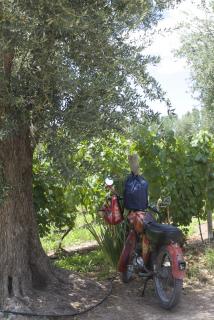 Mendel vineyard, Mendoza, Argentina
Mendel vineyard, Mendoza, Argentina
It could have been better and it could have been worse. Better because much of Argentina’s valuable stock of Malbec was destroyed, not in this case by phylloxera but stupidity. Although by the 1960s, Argentina had some 50,000 hectares of Malbec planted, much of it old vines, it was never considered a major quality grape variety at that time but simply used in blends for what the Argentinians drank as relatively cheap vino fino. Because it was not valued, and because other crops became more valuable, much of Argentina’s great stock of Malbec was pulled out and replaced. It could have been worse because they could have pulled the whole lot up. Luckily, some 10,000-odd hectares remained, enough to found the basis of the modern wine industry which only started to get into its stride in the 1980s.
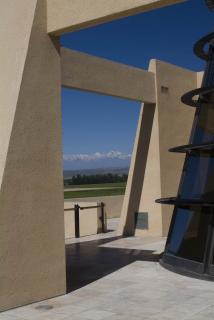 View from Catena Winery
View from Catena Winery
Even Nicolás Catena, widely regarded is the greatest pioneer of Malbec in Argentina today, failed to recognize the grape’s potential until the early 1980s. Enamoured with Cabernet Sauvignon and Chardonnay, Catena only decided to try and revive Malbec because of his father, Domingo’s, wishes. In homage to his Italian background, Catena turned to the old Malbec planted at the family’s Angélica vineyard in Mendoza. The effect was electrifying as he discovered that this old vine Malbec, still know as uva francesa at the time, was capable of producing deliciously rich, fruity reds for which consumers on export markets, notably the US, were prepared to pay top dollar. This discovery that led to a reappraisal of Malbec’s potential in Argentina and a camel train of investors from France, Austria, Switzerland, Holland, Portugal, Chile and the US, piled in, in search of Argentina’s new El Dorado.
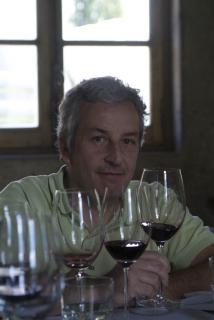 Roberto de la Mota
Roberto de la Mota
Rather like those either side of the Lot River in Cahors, the vineyards on both banks of the Mendoza river were the original locations for quality Malbec. Thus, Roberto de la Mota for instance, who left Terrazas to found his own winery, Mendel, in the early 2000s, was able to locate a vineyard dating from 1928 in the Mayor Drummond district to create a classic Malbec, Mendel Unus. ‘It’s dry here with an important difference between day and night temperatures. This, with altitude at 950 metres and our stony soils helps us give us wines with fresh and floral aromatic profiles’. Today, his 2006 Mendel Unus is a model of its kind.
 In Trapiche's winery, Mendoza, Argentina
In Trapiche's winery, Mendoza, Argentina
Beyond this traditional area, producers are now moving to the more southerly Uco Valley, a Shangri-la-like oasis of unspoilt beauty ranging in altitude from 1100 to 1500 metres. Some of Uco retains that legacy of old Malbec vines thanks to the many immigrant families there who’ve supplied the big companies for decades. These old Malbec vineyards provide a source of some of today’s greatest Argentinian reds, notably Trapiche’s great single vineyard Malbecs, of which the 2006 Trapiche Viña Adriana Venturín, La Consulta, is a masterpiece of opulent blackberry and plum fruit with undertones of chocolate, and Achaval Ferrer’s polished, cherry and mulberry-like 2006 Finca Altamira. According to Achaval’s Italian winemaker, Attilio Pagli, ‘when I stumbled upon Altamira, it was an old, abandoned, flood-irrigated vineyard dating from 1925 and I was struck by the climate, the light and the Malbec itself. I ate the grapes and realised it had world-class potential’.
Traditionally, Uco Valley had been a fertile vegetable and fruit basket with cherry, green apple, peach, almond, walnut, onion and garlic, but it was perhaps Nicolás Catena’s planting of the Adrianna Vineyard at Tupungato in 1993 that set off the stampede for Uco’s best vine territory.
 Adrianna Catena
Adrianna Catena
Here, he was able to show that the effect of solar radiation, and bracingly fresh mountain breezes at altitude was to produce lovely wines with aromatic violet perfumes and smooth-textured dark cherry, mulberry and black fruit flavours. As Doña Paula’s vineyard manager, Edy del Popolo, says, ‘In Uco, you have all the right conditions for big wines, intense in colour, fresh fruit aroma, firm tannic structure, bright acidity, more balanced sugar ripeness, and better ageing potential’.
 Hervé and Diane Joyaux
Hervé and Diane Joyaux
This expansion of Argentina’s Malbec vineyard beyond the core traditional area of Mendoza has been echoed by its extension to Argentina’s northern province of Salta and as far down south as the vine grows in Patagonia. One of the best exponents of the variety in Salta’s Calchaquí Valley is the self-styled ‘lone wolf’, Swiss businessman Donald Hess, whose Colomé Estate at 2,200 metres in the Andes is one of the highest vineyards in the world. The mountain Malbec here is richly coloured and sturdy. In the far south in Patagonia, Hervé Joyaux Fabre and his wife Diane, who also have vineyards in Mendoza, believe that the more southerly latitude compensates for relative lack of altitude at 250 metres. Proof of the pudding is their 2006 Viñalba Malbec Syrah, a remarkable value under £10 blend which won a trophy at this year’s International Wine Challenge.
More than a century’s transformation of the Malbec grape in Argentina’s sun-drenched uplands into an exotic beauty makes it easy to overlook the beast in the variety. In Cahors, Malbec has had a tendency to be deceptively tannic. According to newcomers to Cahors, Sue and Mike Spring, who own a tiny 2.5 hectare property at Domaine du Garinet, ‘a lot of Cahors was thin on fruit and high in tannin and not very attractive. People got what they got rather than what they chose. It’s getting better now’. In place of Argentinian Malbec’s sweet ripe puppy fat, the Malbec of Cahors often shows a spine of tannin and natural acidity that tends to greater austerity, longevity and savoury notes of sour cherry, plum and damson. In fine vintages like 2005 and 2007, it can be delicious; in others more problematic.
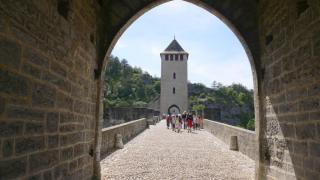 Cahors: sur le Pont Valentré, on y danse
Cahors: sur le Pont Valentré, on y danse
New rules allowing Cahors producers to blend in up to 30 per cent of Merlot and Tannat have helped to introduce a fruitier, more approachable red. Leading estates like Clos Triguedina, Château Haute Serre and Domaine de Gaudou are exponents of the glossier new style. Determined to tame Cahors rough edges, outside investors such as luxury goods businessman Alain Dominique Perrin (Château Lagrézette) and the aptly named youthful software magnate, Philippe Lejeune (Château Chambert), are joined in this vision by talented growers at Domaine du Cèdre, La Bérangerie and Cosse Maisonneuve. According to the ubiquitous consultant Michel Rolland, ‘no-one thought about changing things 20 years ago because the knowledge wasn’t there; but we know today that with better viticulture and control over yields, we can make big improvements in the wine’. Could Cahors then take back the Malbec mantle it lost to Argentina all those years ago? Only time, and global warming perhaps, will tell.
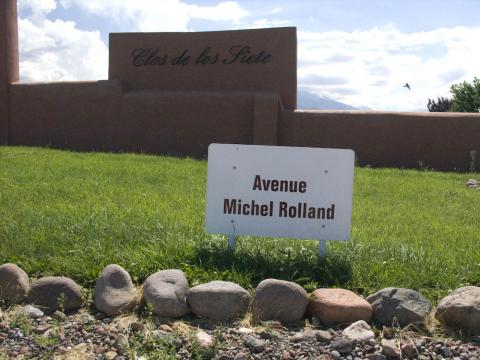 Clos de los Siete avenue named after a well-known French wine consultant
Clos de los Siete avenue named after a well-known French wine consultant

